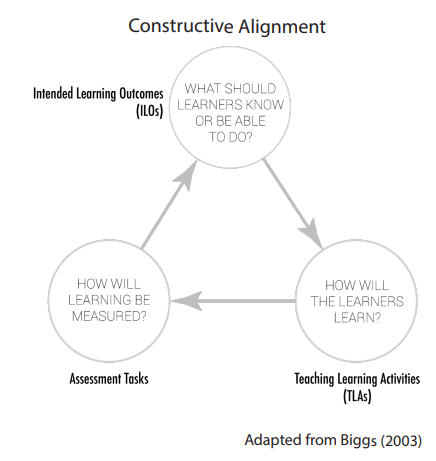Linking learners to their learning goals: constructive alignment and assessment design

What is constructive alignment?
Constructive alignment is a term that was coined by renowned education academic John Biggs in 1999. In simple terms, it means that all assessment tasks and learning and teaching experiences (including content and methods) must link directly to the learning outcomes of a particular unit of study.
(The University of Queensland, 2018)
According to Biggs (2003, p.27):
The ‘constructive’ aspect refers to what the learner does, which is to construct meaning through relevant learning activities. The ‘alignment’ aspect refers to what the teacher does, which is to set up a learning environment that supports the learning activities appropriate to achieving the desired learning outcomes.
In order to be able to demonstrate constructive alignment, you have to start with the outcome statements or Learning Outcomes (LOs). The verb chosen for these statements need to indicate what the relevant learning activities are that the students need to undertake in order to achieve the intended learning outcome, for example ‘demonstrates’ or ‘describes’. Learning is constructed by the activities that the students engage in. Learning is about what the students do, not about what we as teachers do. Bloom’s taxonomy of measureable verbs will help you in the construction of appropriate LOs. Click here for a practical toolkit.
Constructive alignment and assessment design
The final part of the alignment process is the appropriate design of assessment. Assessments should be a fair opportunity for all students to demonstrate how well they have achieved the intended outcomes. According to Biggs (2003, p. 27), assessment should not be “about how well they report back to us what we have told them or what they have read”, but about how students demonstrate learning in relation to the unit learning outcomes.
No matter where in the world you teach, constructive alignment is what regulators are looking for across courses of study to ensure transparency between program learning outcomes, unit learning outcomes, what we teach every week in class and what we test our students on in assessments. This is in response to the increasing massification of higher education resulting in a diverse cohort of students that have different learning needs. Constructive alignment ensures transparency and fairness for all students. Gone are the days of including trick questions or questions that you think students ‘should know’ but you didn’t teach, or bonus questions about content that wasn’t included in the course.
Curtin College’s workshop on constructive alignment
Bronwyn ran multiple face-to-face workshop sessions at Curtin College in Perth, Western Australia, to continue building staff knowledge and awareness around this topic. View the slides from the workshop below:
Here are practical checklists that can be applied to any individual assessment or course at your institution to help support staff in designing assessments for constructive alignment:
Individual and Unit Assessment Design ChecklistTo continue the conversation, contact Bronwyn Mortimer or Gemma Clarke, or share your thoughts and ideas via Yammer, Twitter or LinkedIn.
References
- Biggs, J.(1999). What the Student Does: teaching for enhanced learning, Higher Education Research & Development. doi: 10.1080/0729436990180105
- Biggs, J. (2nd Eds.). (2003). Teaching for quality learning at university. Buckingham: Society for Research into Higher Education.
- The University of Queensland. (2018). Constructive alignment. Retrieved from http://www.uq.edu.au/teach/flipped-classroom/docs/FAB/Constructive%20Alignment%20FINAL.pdf
- Utica College. (2018). Bloom’s Taxonomy of Measurable Verbs. Retrieved from http://www.utica.edu/academic/Assessment/new/Blooms%20Taxonomy%20-%20Best.pdf
